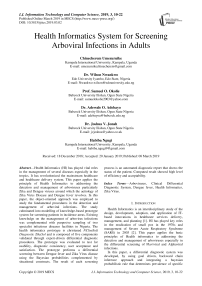Health informatics system for screening arboviral infections in adults
Автор: Chinecherem Umezuruike, Wilson Nwankwo, Samuel O. Okolie, Adewale O. Adebayo, Joshua V. Jonah, Habiba Ngugi
Журнал: International Journal of Information Technology and Computer Science @ijitcs
Статья в выпуске: 3 Vol. 11, 2019 года.
Бесплатный доступ
Health Informatics (HI) has played vital roles in the management of several diseases especially in the tropics. It has revolutionized the mainstream healthcare and healthcare delivery system. This paper applies the principle of Health Informatics to addressing the detection and management of arboviruses particularly Zika and Dengue viruses around which the aetiology of Zika Virus Disease and Dengue fever revolves. In this paper, the object-oriented approach was employed to study the fundamental procedures in the detection and management of arboviral infections. The study culminated into modelling of knowledge-based prototype system for screening patients in incidence areas. Existing knowledge on the management of arbovirus infections was complemented with purposive sampling of two specialist infectious diseases facilities in Nigeria. The health informatics prototype is christened NCliniSoft Diagnostic ZikaSol and is composed of five components validated through expert-driven differential diagnostic procedures. The prototype was evaluated to test for usability, diagnostic consistency, user acceptance and satisfaction. The prototype performs a differential screening between Dengue fever and Zika Virus disease using the Bayesian probabilities complemented by situational constructs. The result of each screening process is an automated diagnostic report that shows the status of the patient. Computed result showed high level of efficiency and acceptability.
Arboviruses, Clinical Differential Diagnostic System, Dengue fever, Health Informatics, Zika Virus
Короткий адрес: https://sciup.org/15016341
IDR: 15016341 | DOI: 10.5815/ijitcs.2019.03.02
Список литературы Health informatics system for screening arboviral infections in adults
- National Library of Medicine. (2009). Artificial Intelligence. Retrieved August 10, 2018, from https://hsric.nlm.nih.gov/hsric_public/display_links/717
- Knobler, S., Mahmoud, A., Lemon, S., Mack, A., Sivitz, L., & Oberholtzer, K. (2004). Learning from SARS: Preparing for the Next. Retrieved October 31, 2016, from https://www.ncbi.nlm.nih.gov/books/NBK92462/pdf/Bookshelf_NBK92462.pdf
- Paixão, E.S., Barreto, F., Teixeira, M.G., Costa M.C., and Rodrigues L.C.(2016) "History, Epidemiology, and Clinical Manifestations of Zika: A Systematic Review.", American journal of Public Health, Vol. 106, Issue 4, pp 106-112. doi: 10.2105/AJPH.2016.303112.
- Nigeria Center for Disease Control (2016, October). Public Health Risk Assessment Of Zika Virus In Nigeria and Interim Recommendations. Abuja: Nigeria Center for Disease Control. Accessed June 1, 2018, from http://www.ncdc.gov.ng/themes/common/docs/protocols/12_1478775264.pdf
- Centres for Disease Control and Prevention (2016) "Country Classification Technical Guidance"[online]. Available at: https://wwwnc.cdc.gov/travel/page/zika-country-classification [Accessed 17 February 2018]
- Fagbami, A. H. (1979). Zika virus infections in Nigeria: virological and seroepidemiological investigations in Oyo State. J Hyg, 84, 213 - 219.
- Cao-Lormeau, V. M., & Musso, D. (2014). Emerging arboviruses in the Pacific. Lancet, 384(9954), 1571–2.
- Duffy M. R. et al(2009) " Zika virus outbreak on Yap Island, Federated States of Micronesia", New England Journal of Medicine, Vol. 360, Issue 24, pp 536-43. doi: 10.1056/NEJMoa0805715
- Faria, N. R., Azevedo, R. D. S. D. S., Kraemer, M. U. G., Souza, R., Cunha, M. S., Hill, S. C. l., ... Vasconcelos, P. F. C. (2016). Zika virus in the Americas: Early epidemiological and genetic findings. Science Journal, 352(6283), 345 - 349. Retrieved May 2, 2017, from ttp://evolve.zoo.ox.ac.uk/Evolve/Oliver_Pybus_files/ZikaVirusInTheAmericas.pdf
- Petersen L. R., Jamieson D. J., Powers A. M., & Honein M. A. (2016). . Zika virus. The New England Journal of Medicine, 374(16), 1552–1563.
- World Health Organisation (WHO). (2016, February 26). 2016 Public Health Emergency of International Concern . Retrieved December 30, 2016, from World Health Organisation: http://www.who.int/emergencies/zika-virus/en/
- Dowall S. D., Graham V. A., Rayner E., Atkinson B., Hall G., Watson R. J., Bosworth A., Bonney L. C., Kitchen S, & Hewson R. (2016). A Susceptible Mouse Model for Zika Virus Infection. PLoS Neglected Tropical Diseases, 10(5). Retrieved December 1, 2017, from https://www.ncbi.nlm.nih.gov/pmc/journals/532/
- Onuorah, M., Adam,u A., Obi, E. I., & Hasheem A. M. (2016). Deterministic Mathematical Model of Zika Virus. Researchjournali’s Journal of Mathematics, 3(3), 1 - 16.
- Blázquez,A. and Saiz,J. (2016) "Neurological manifestations of Zika virus infection", World Journal of Virology Vol. 5, No.4,pp 135–143. doi: 10.5501/wjv.v5.i4.135
- Tripathi, S., Balasubramaniam, V.R.M.T., Brown, J. A., Mena, I., Grant, A., Bardina, S. V., … Garcı ´a-Sastre, A., et al. (2017). A novel Zika virus mouse model reveals strain specific differences in virus pathogenesis and host inflammatory immune responses. PLOS Pathogens, 13(3), 1 -19.
- Olson, J.G., Ksiazek, T.G., Suhandiman, & Triwibowo(1981) "Zika virus, a cause of fever in Central Java, Indonesia", Trans R Soc Tropical Medicine Hygiene, Vol. 75, Issue 3: pp 389-393
- Hole, K.R., & Gulhane, V.S. (2014). Rule-based expert system for the diagnosis of memory loss disease. International Journal of Innovative Science, Engineering and technology Vol 1 Issue 3
- Patel, M.,Patel, A., & Virparia , P (2016). Rule based expert system for viral infection diagnosis. International journal of Advancedresearch in Computer Science abd Software Engineering
- Ekong, V.E., Inyang, U.G., & Onibere E.A. (2012). Intelligent decision support system for depression diagnosis based on neuro-fuzzy CBR Hybrid. Retrieved on January 20, 2018 from https://researchgat.net/publication/235435577
- Abu Naser S., Al-Dahdooh R., Mushtaha, A., & El-Naffar M. (2010). Knowledge Management in ESMDA: Expert System for Medical Diagnostic Assistance. ICGST-AIML Journal, 10(1), 31 - 40.
- World Health Organization (2017) "Zika virus country classification scheme"[online]. Available at http://apps.who.int/iris/bitstream/10665/254619/1/WHO-ZIKV-SUR-17.1-eng.pdf?ua=
- Kaasbøll, J. J.(1996). Aspects of object-oriented modelling: concepts for analysis and guidelines for design. Oslo: Nonnon.
- Mathiasen, L., munk- Nielsen, A., Nielsen, P.A and Stage, J. (2000). Object oriented Analysis and Design. Aalborg, Denmark: Marko Publishing Aps.


